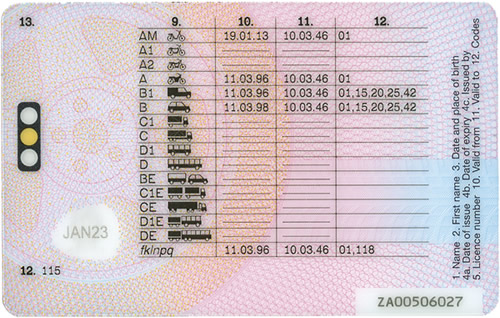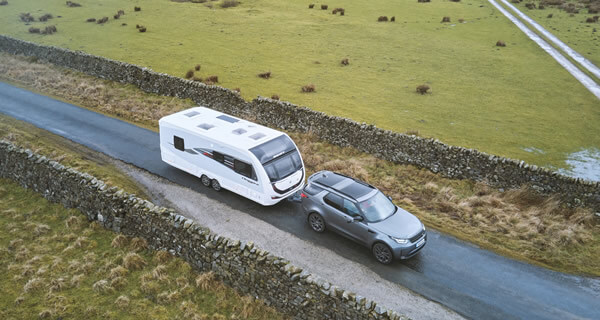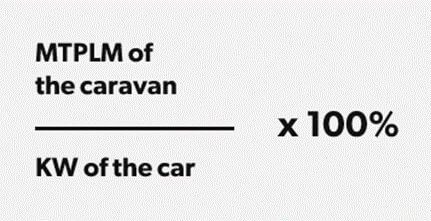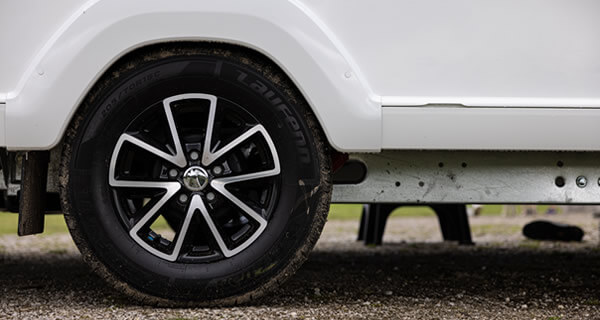Your guide to what caravan weight you can tow
Published:
The caravan weight you can tow here in the UK depends on a number of factors, including your driving licence, the vehicle you are driving, and the caravan you intend to tow.
Firstly, check the back of your driving licence card to establish what you are currently entitled to drive. As you can see from the example licence image below, your card will give you the start and expiry dates against the category you are permitted to drive.

Understanding the driving categories
Category B
This is the standard car licence issued, but if you passed your driving test before 1 January 1997, you can drive a vehicle and caravan combination of up to 8,250kg maximum authorised mass (MAM).
If you passed your driving test on or after 1 January 1997, you can:
- Drive a car up to 3,500 kg MAM, towing a caravan of up to 750kg MAM
- Tow a caravan over 750kg MAM as long as the combined MAM of the caravan and towing vehicle is no more than 3,500kg
Category BE
This is a car and trailer licence category that allows you to drive a vehicle with a MAM of 3,500kg with a caravan. The size of the caravan depends on the BE ‘valid from’ date shown on your licence. If the date is:
- Before 19 January 2013, you can tow any size caravan within the towing limits of the vehicle
- On or after 19 January 2013, you can tow a caravan with a MAM of up to 3,500kg within the towing limits of the vehicle
Category C1
The C1 allows you to drive vehicles between 3,500 and 7,500kg MAM with a caravan of up to 750kg.
Category C1E
The C1E category allows you to drive C1 category vehicles with a caravan that weighs over 750kg, however the combined MAM of both cannot exceed 12,000kg.
Category C
This allows you to drive vehicles over 3,500kg with a caravan of up to 750kg MAM.
Category CE
This allows you to drive category C vehicles with a caravan over 750kg.

"Your Swift owners handbook will give you more specific details on weights of your caravan. You'll also find a useful towing guide with tips on loading your caravan, towing stability and arriving at a campsite."
Jo Mitchell, Marketing Director at Swift
Determining your vehicle’s towing capacity
It’s important to remember that each vehicle has its own specific towing capacity, and this information is usually found within the vehicle’s manual or on the manufacturer’s website.
Your manual will give you an understanding of the maximum weight of your vehicle (fully loaded), the maximum weight it can tow, and the total allowable weight of the vehicle and trailer combined.
This capacity is a crucial specification that ensures the vehicle can handle the additional load without compromising safety, performance and longevity.
To calculate if your fully loaded caravan is appropriate for your towing experience we use the Kerb Weight (KW) of your vehicle, which is usually found on the V5 registration document.

Calculating your caravan/car weight ratio
To calculate this, you will need to know two key figures: the KW of the vehicle and the Maximum Technical Laden Mass (MTPLM) of the caravan. Divide the MTPLM by the KW and times by 100%.

For a novice caravanner, ideally, this ratio should not exceed 85%. If it’s between 85% and 100%, only experienced caravanners should tow such a heavy weight.
Remember that the weight of your personal effects and any optional equipment you have fitted will affect the result. Try to keep the caravan as light as possible - the lower the weight, the better the match and the safer it is to tow.
Finally, it’s important to note that care must always be taken not to exceed the car’s loading and towing limits including the combined MAM which takes preference over the weight ratios as mentioned above.
Just to note, there are different rules for towing if you live in Northern Ireland.
Tips for safe towing
Ensure your touring caravan is loaded correctly with the weight distributed evenly, and ensure any heavy items are placed low and close to the axle to maintain a low centre of gravity.
Check that your insurance policy covers towing, by having the right cover and understanding the coverage details, you can ensure protection for both your vehicle and caravan while on the road.
Ensure all tyres on both the caravan and towing vehicle are inflated to the manufacturer’s recommended pressures. Incorrect tyre pressure can affect handling and fuel efficiency. Regularly inspect tyres for wear and tear, and replace them as needed.

Adjust your driving style when towing, taking into account the extra weight and length. Maintain a moderate and steady speed, avoiding sudden movements and allow extra braking distance.
If you’re new to towing, practice reversing, turning, and parking in a safe, open area. Get comfortable with the handling and braking of your towing setup before heading out on long trips.
Weights explained
Mass in running order (MRO) also known as unladen weight, is the mass of the empty caravan as supplied by the manufacturer including loose items such as the hook-up cable, kit bag, entrance step, manuals etc. Please allow 10kg for LPG (your Liquefied Petroleum Gas bottle).
Maximum Authorised Mass (MAM) which is also referred to as Maximum Technical Laden Mass (MTPLM) is the weight of a caravan including the maximum load that can be carried safely when it’s being used on the road. You'll find this in your owner’s manual.
Gross train weight (GTW), also sometimes called gross combination weight (GCW) is the total weight of the tractor unit plus trailer plus load.
Kerb Weight (KW) is generally the weight of the car in working order (with fuel and fluids). Depending upon the exact definition used by the car manufacturer, this may include a 68kg allowance for the weight of a driver and a 7kg allowance for luggage, but will not include a weight allowance for passengers or their luggage. Most car manufacturers now include the driver in their KW.
Summary
In summary, when determining how much weight you can tow, key factors such as your vehicle's towing capacity and the weight specifications of the caravan need to be understood to ensure all capacities are within the specified limits. You will also need to check your driving licence to establish what you are currently entitled to tow with your vehicle.